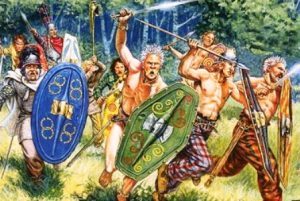
Celts occupied land in modern day Eastern Europe, Greece, Spain, Northern Italy, Western Europe, England, Wales, Scotland and Ireland. The Celtic people have mystified anthropologists and historians for generations. They were a non-literate culture whose history and literature was preserved through oral tradition. The only written records of their civilization are the texts left by classical authors, the first of which appear circa 500 BCE. These accounts, inaccurate as they may be, are important in that they demonstrate that the Celts came into cultural contact, and sometimes competition, with the Greeks as well as the Romans.
In recent years, modern archeology has been successful in reconstructing an echo of the “voice” of the ancient Celts. Facets of Celtic society, economy, and religion completely ignored by Classical texts have been brought to light. The classical image of Celtic life describes barbaric men and women dressed in uncured animal skins in primitive villages, people who worshipped strange deities and whose lives were consumed in blood feuds. Because of the authority of the classical authors, these ancient misconceptions were pervasive. They are visible, for example, hundreds of years later in some of the Shakespearean characters that people Cymbeline and King Lear.
 The Celts impressed the Greeks and Romans with their bold dress and powerful appearance. Generally characterized by classical observers as a people of fair hair, of red or gold, and fair complexions, (although the people of the British Isles were described as small and dark-haired) most Celtic women apparently stood taller than the average Roman citizen. Celtic women, upon reaching maturity, adopted a complex braided style for their hair, and wore dyed and embroidered dresses. Plaids, or wrapped woven cloaks, were common for men and women alike, and gold and silver torques and arm rills, as well as rings, adorned wealthy Celts. Brooches that held closed the openings of dresses and plaids were another common feature of Celtic dress. Gallic men commonly spiked their hair and bleached it to an almost white color with chalky water, and wore their beards long, while the Bretons and Picts tattooed their arms and faces with blue.
The Celts impressed the Greeks and Romans with their bold dress and powerful appearance. Generally characterized by classical observers as a people of fair hair, of red or gold, and fair complexions, (although the people of the British Isles were described as small and dark-haired) most Celtic women apparently stood taller than the average Roman citizen. Celtic women, upon reaching maturity, adopted a complex braided style for their hair, and wore dyed and embroidered dresses. Plaids, or wrapped woven cloaks, were common for men and women alike, and gold and silver torques and arm rills, as well as rings, adorned wealthy Celts. Brooches that held closed the openings of dresses and plaids were another common feature of Celtic dress. Gallic men commonly spiked their hair and bleached it to an almost white color with chalky water, and wore their beards long, while the Bretons and Picts tattooed their arms and faces with blue.
Many Danish and English bogs have yielded archeological evidence of cloth and dress, and Roman historians such as Tacitus also document some of the customs of everyday Celtic life.
Some features of Celtic life were not as closely chronicled in classical sources. The quality of Celtic metal-work was technically and artistically advanced. Most Celtic people lived in well-populated farming villages, with larger towns linking smaller settlements and acting as meeting sites for economic and cultural activity. Fortified cities and shrines were erected along well-travelled roadways. This evidence of a more complex society in pre-Roman Europe has led some scholars to rethink conclusions drawn from classical texts by such authors as Caesar, Polybius, and Strabo. Celtic societies, once considered “barbaric” as seen through the lens of classical observers, are now looked upon as advanced cultures networked through the bond of a common linguistic heritage.
Piecing together the culture and lives of the ancient Celts, in the absence of clear archeological or textual record, is not an easy task. No one is even sure where the term “Celtic” comes from. With a great deal of inconsistency, classical sources provide tantalizing but incomplete information about the peoples called Keltoi and Galatea by the Greeks, and Celtae or Galli by the Romans. Two thousand years ago, the term Celt was used specifically for peoples inhabiting continental Europe; the denizens of England and Ireland were not to be called “Celts” until seventeenth and eighteenth-century linguistic scholarship began to identify the inhabitants of the pre-Roman British Isles as Celtic peoples.




















Leave a Comment